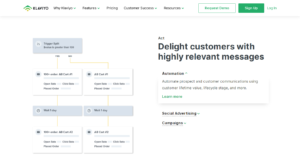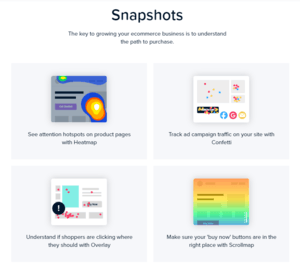Shopify’s app store has thousands of apps claiming to be the solution to boosting your online sales.
But…
It’s impossible to filter through all these tools, especially when most of them are expensive and bring no value to your store.
Which is why we decided to share this list with you…
In our longstanding expertise, here are the best 5 Shopify apps to boost sales and profits:
1- Klaviyo
For decades, email has proven to be a very effective marketing technique for ecommerce stores. But as your companies grow, managing every aspect of the business can get a lot harder.
That’s why you need Klaviyo.
Klaviyo is an email marketing app that helps you automate email campaigns for your business. It’s the ultimate time and money saver as it helps you create personalized email sequences using pre-built templates depending on your marketing goals.
Some of its key features include:
- Post-purchase follow up email sequences
- Email personalization
- Audience segmentation (based on behavior, location, etc)
- Performance reports and data analytics
- A/B testing
2- Recart
Cart abandonment is often one of the biggest challenges for online businesses. Imagine moving a target customer all the way to the bottom of the funnel, and then losing them moments before they convert.
Does that sound familiar?
Then Recart is the answer…
Cart abandonment emails are still super effective in recapturing lost leads. However, focusing on other platforms where your audience might be present — such as Facebook and Messenger — is a must.
With features like push notifications, on-site popup messages, and Messenger marketing campaigns, Recart is the best solution to recovering lost leads.
The tool also offers detailed analytic reports to help you optimize your campaigns and focus on improving what’s important.
3- Zipify — OneClickUpsell
It’s hard to sell a single product, let alone multiple items at once. But that’s only true if you’re not using Zipify’s One-Click-Upsell (OCU).
OCU is the go-to solution for promoting matching products in your store to interested customers pre or post-purchase. It’s the best tool to upsell upgrades, add-ons, or accessories to engaged customers.
Moreover:
OneClickUpsell allows you to easily customize your product and subscription pages without the help of a developer. With a few simple tweaks, you can add testimonials or display similar products to encourage your leads to buy more.
As if that’s not enough…
OCU also comes with highly converting email sequences that you can use to retarget customers and boost your sales.
4- Trackify
No matter how great your products, branding, and marketing campaigns are, you’re not going to win unless you target the right audience.
And that’s exactly what Trackify is for…
Trackify is an all-in-one Facebook pixel app that helps store owners reduce ad spend and maximize their results. But what makes it even more interesting are the excellent features that come with it.
For example:
You can easily integrate a pixel with your Shopify store, then create specific tags for different products. Which allows you to run highly targeted ad campaigns on Facebook.
After that, you’ll be able to build and segment different audiences focusing on specific product pages.
Beyond that:
You can integrate Trackify with any Shopify app or theme you’ve installed on your website. Which makes it an excellent option compared to other Facebook pixel apps.
Another thing worth mentioning is the outstanding customer support offered by the company. You can jump on the live chat anytime and get your questions answered within minutes of asking them.
5- Crazyegg
Crazyegg helps you get a visual representation of how users are interacting with your website. You’ll be able to see how visitors scroll on the page, how their mouses move, and which parts they click on.
The two main features of Crazyegg are heatmaps and scroll maps.
For heatmaps, you’ll identify the places your leads click on the most, which are called hotspots in the app. Such data helps you better place important elements or buttons on your sales pages.
Scroll maps, however, show how users are scrolling on the page and how long they spend reading different sections. This feature is best used with long landing pages or sales offers to help you better reorganize your layouts.
Ready to Skyrocket Your Shopify Business?
ChaosMap can help! We’re a team of online sales and advertising experts ready to help you maximize your profits with your E-commerce stores.
Feel free to check out our digital marketing services to learn more. And don’t hesitate to contact us today so we can discuss your project needs.






















 Baseball is the second most popular sport in the United States, second only to football. But it didn’t get that way overnight. Great players, a season format that promotes suspense and great marketing has helped Major League Baseball maintain and expand viewership through generations.
Baseball is the second most popular sport in the United States, second only to football. But it didn’t get that way overnight. Great players, a season format that promotes suspense and great marketing has helped Major League Baseball maintain and expand viewership through generations.